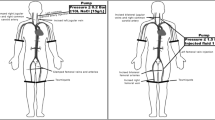Abstract
The purpose of this experimental study was to establish a short-term post-mortem circulation in a pig model using liquid paraffin. This study also investigated the quality of vascular perfusion in the peripheral tissues. This is the first step in the development of a new revascularized human surgical training model. This first experience was performed on the hind leg of a pig. Initial cannulation of the external iliac artery and vein was followed by connection of the arterial inflow to a heart–lung machine and using the venous outflow to flush post-mortem clots and blood. Subsequently, after connecting the venous outflow to the heart–lung machine, circulation was initiated. Circulation was established during 27 min, during which the flow was constantly 130 mL/min. A steady increase in inlet pressure was observed during the experiment, which finally reached a minimum value of 124 mmHg. Perfusion was interrupted early due to an uncontrollable fluid leak. Afterwards, the distal hind leg was incised showing an equal distribution of paraffin. A short-term revascularization was successfully re-established under excellent conditions. Although the results are promising, further experiments are necessary to eventually perform a wide range of surgical procedures on revascularized human cadavers.





Similar content being viewed by others
References
Kroeze SG, Mayer EK, Chopra S, Aggarwal R, Darzi A, Patel A (2009) Assessment of laparoscopic skills of urology residents: a pan European-study. Eur Urol 56:865–872
Aggarwal R, Crochet P, Dias A, Misra A, Ziprin P, Darzi A (2009) Development of a virtual reality training curriculum for laparoscopic cholecystectomy. Br J Surg 96:1086–1093
Cavallari G, Tsivian M, Neri F, Bertelli R, Faenza A, Nardo B (2009) Hand-assisted laparoscopic donor nephrectomy: analysis of the learning curve in a training model in vivo. Transplant Proc 41:1125–1127
Kerckaert I, Van Hoof T, Pattyn P, D’Herde K (2008) Endogent: centre for anatomy and invasive techniques. TSACA 2:28–33
Garrett HE (2001) A human cadaveric circulation model. J Vasc Surg 33:1128–1130
Aboud E, Moursi M (2010) Live cadavers for laboratory training in vascular surgery. J Vasc Surg 51:46S–S
Grabherr S, Doenz F, Steger B, Dirnhofer R, Dominguez A, Sollberger B, Gygax E, Rizzo E, Chevallier C, Mueli R, Mangin P (2010) Multi-phase post-mortem CT angiography: development of a standardized protocol. Int J Legal Med 125:791–802
Grabherr S, Djonov V, Friess A, Thali M, Ranner G, Vock P, Dirnhofer R (2006) Postmortem angiography after vascular perfusion with diesel oil and a lipohilic contrast agent. AJR 187:515–523
Grabherr S, Gygax E, Sollberger B, Ross S, Oesterhelweg L, Bolliger S, Christe A, Djonov V, Thali M, Dirnhofer R (2008) Two-step postmortem angiography with a modified heart-lung machine: preliminary results. AJR 190:345–351
Chobanian A, Bakris G, Black H, Cushman W, Green L, Izzo J Jr, Jones D, Materson B, Oparil S, Wright J Jr, Roccella E (2003) Seventh report of the Joint National Committee on Prevention, Detection, Evaluation, and Treatment of High Blood Pressure. Hypertension 42:1206–1252
Jackowski C, Bolliger S, Aghayev E, Christe A, Kilchoer T, Aebi B, Périnat T, Dirnhofer R, Thali M (2006) Reduction of postmortem angiography-induced tissue edema by using polyethylene glycol as a contrast agent dissolver. J Forensic Sci 51:1134–1137
Acknowledgments
We would like to thank Wim Ceelen, MD, PhD, FACS, for his critical review of the article.
Conflict of Interest
The authors declare no conflict of interest.
Author information
Authors and Affiliations
Corresponding author
Rights and permissions
About this article
Cite this article
Willaert, W., De Somer, F., Grabherr, S. et al. Post-mortem Reperfusion of a Pig: a First Step to a New Surgical Training Model?. Indian J Surg 77 (Suppl 2), 712–715 (2015). https://doi.org/10.1007/s12262-013-0961-x
Received:
Accepted:
Published:
Issue Date:
DOI: https://doi.org/10.1007/s12262-013-0961-x




